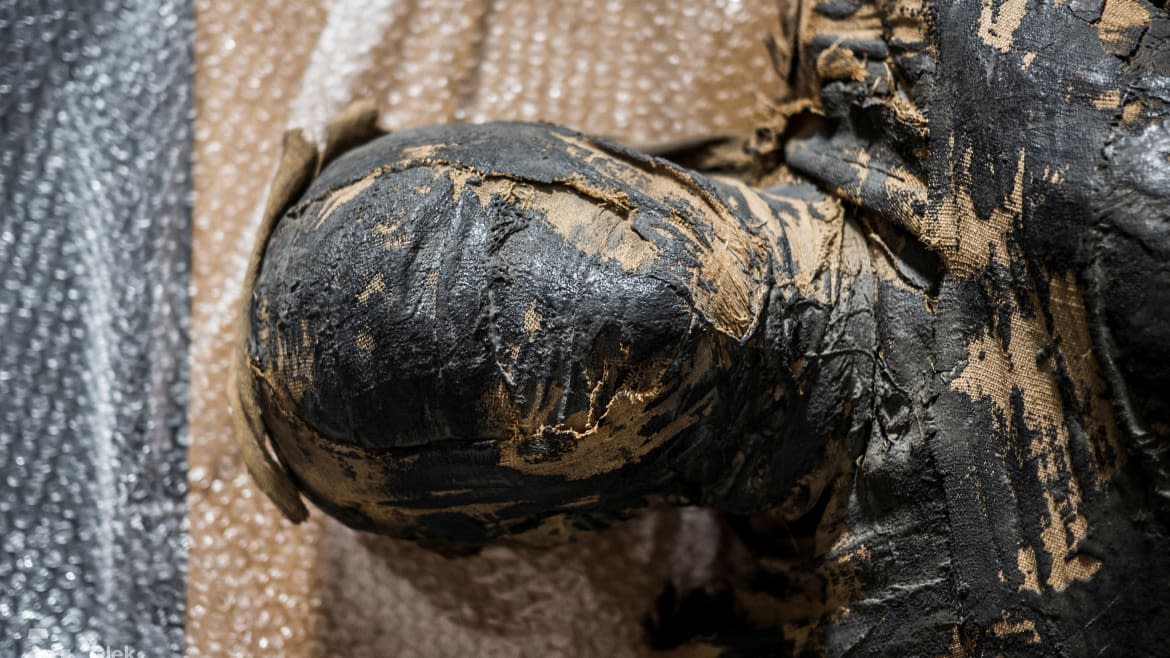The Mysterious Case of the Body-Swapping Pregnant Mummy

In 2015 scientists in Poland were in the midst of a large comprehensive study of the National Museum in Warsaw’s mummy collection when they ran across something strange. An Egyptian mummy that, for decades, had been thought to be the remains of an ancient male priest had something unusual in its pelvis area.
The anthropologist was examining the pelvic area of the mummy to confirm the sex of the remains when he noticed an “anomaly”: a tiny foot. This was not the body of a male religious leader it was that of a woman. The surprising discovery is the first time that archaeologists have discovered the remains of a mummified pregnant woman.
The mummy first arrived in at the University of Warsaw in 1826. The donor supplied correspondence that indicated the mummy was discovered in the famous royal tombs at Thebes, but nineteenth century accounts of origins are notoriously unreliable. Vendors of antiquities often connected their discoveries to celebrity sites in order to inflate their value for sale. For nearly two centuries afterwards inscriptions on the sarcophagus led scientists to believe that the mummy was a male priest named Hor-Djehuti. It seems likely that the woman had been placed in the wrong coffin by 19th century antiquities dealers. Archaeologist Dr. Wojciech Ejsmond, of the Polish Academy of Sciences and director of the Warsaw Mummy Project, said that the inaccurate matching of mummies and coffins happens in about ten percent of cases.
The noninvasive scanning technology used as part of the Warsaw Mummy Project has revealed the truth. The Mysterious Lady of the National Museum in Warsaw, as she is now known, lived during the first century BCE and was in her twenties when she died. The circumference of the head of her unborn child suggests that she was between 26 and 30 weeks pregnant when she died. Fifteen items, including a set of valuable mummy-shaped amulets, were found among the mummy wrappings. Given the money invested in her burial she is likely to have been a high-status woman, but her hometown, family life, and cause of death are currently unknown.
Radiological images revealed that four bundles have been placed in abdominal cavity. Traditional Egyptian mummification practice removed and embalmed select internal organs that were believed to be valuable for the afterlife and experts believe that the parcels contain these organs. Interestingly, however, the fetus remained intact in the uterus. Perhaps removing it was too difficult for Egyptian mortuary workers or perhaps the fetus was left where it was for religious reasons. It’s anyone’s best guess.
Ejsmond told the Associated Press that “This is our most important and most significant finding so far, a total surprise.” While the remains of pregnant women have been unearthed before in Egypt, this is the first time that mummified remains have been discovered. The condition of the woman’s body offers a rare opportunity to scrutinize ancient women’s health, diet, and lifestyle more closely. “It’s like finding a treasure trove while you are picking up mushrooms in a forest,” Dr. Ejsmond said, “We are overwhelmed.”
The discovery shines a spotlight on our piecemeal understanding of the history of ancient women. Though, as UCLA Egyptologist Kara Cooney has written, some ancient Egyptian women, like Neferusobek, Nefertiti, and Cleopatra actually ruled ancient Egypt there’s still a great deal that we don’t know about the lives of more ordinary people.
In the first century BCE Egypt was controlled by a succession of Greek and Roman rulers. Alexander the Great had conquered Egypt in 332 BCE and was the region was ruled in the aftermath of his death by the Ptolemies. But by the first century BCE the Ptolemaic dynasty had grown weak and Egypt was under the power of the now-powerful Roman Republic. The last and best known of the Ptolemaic rulers, Cleopatra, died in 30 BCE from suicide by snake bite.
Most of the knowledge that we have about women in this period comes from Greek texts written on papyri that were preserved in Egypt’s soil. Dr. Alexander Nagel, a Residential Research associate with the Smithsonian Institution’s National Museum of Natural History and an assistant professor at SUNY (FIT), told The Daily Beast that letters written by women often reveal the need for childcare assistance and support during pregnancy and childbirth. In one late papyrus he mentioned “a seven-month pregnant woman who had a female servant states that her servant would have to do more work now.” This was potentially, Nagel added, because the woman’s father was sick and her husband was away. I’m sure many modern mothers can relate to the struggle.
Other papyri Nagel pointed to paint an even grimmer picture: one papyrus tells the story of a woman who died four days after giving birth to an eight-month old fetus. Pregnancy was dangerous and some women wore amulets of the hippo demon Taweret to protect themselves during pregnancy. Just like today, Nagel told me, “healthcare depended on social status…women who did not need to work because their husband provided them with income had easier access to better healthcare.” Women who worked in temples as priestesses, musicians, or nurses may have been able to lean on one another for practical support and medical advice.
We do not yet know how or why the woman died. Perhaps her death was accidental, connected to her pregnancy, or was the result of an unrelated illness or health condition. Dr. Marzena Ożarek-Szilke, one of the researchers on the project, indicated that the team hope to examine a small amount of tissue in order to establish cause of death. “It is exciting, said Nagel “that non-invasive technologies can help us to understand better the…unfortunate death of a pregnant woman who lived 2,000 years ago.”
Get our top stories in your inbox every day. Sign up now!
Daily Beast Membership: Beast Inside goes deeper on the stories that matter to you. Learn more.

